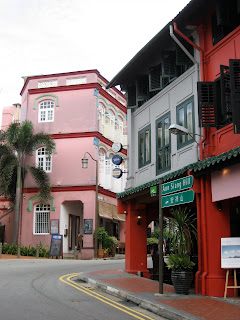Some say Singapore is boring, sterile, over-regulated place but coming from Saigon, it’s always a pleasure to stroll the clean streets of the Lion City.
There may be a few too many signs telling you what not to do, and your penalty for doing it anyway. There may be a few too many never-ending shopping centres that seem to be designed to disorient. But then there is the food, sold in open air food courts with literally hundreds of stalls, offering Chinese, Malay, Indian, Singaporean dishes and so packed at meal times that you may end up wandering with your tray piled with food, despairing of ever actually getting to eat it. (That wouldn’t have been me, of course).
As exemplified by the food, Singapore truly is a multicultural place, which those people who dismiss it as boring seem to ignore or not see. Maybe they didn’t go to Little India, or Chinatown or Arab Street.
Staying in Chinatown was a good way to see the old and the new Singapore. There were the old men playing checkers in the square on Sunday afternoon, surrounded by spectators. There were the heady smells of traditional medicine shops, of roast pork and soup broth. But you also couldn’t ignore the tourist shops and stalls, and the old Chinese shop houses now renovated to become boutiques, cafes, beauty spas and hotels.
Of course it’s a shame to lose the character of the shop houses as the traditional businesses are pushed out. But at least this kind of gentrification retains the old structures. They are safe from being bull dozed into another dull high-rise, as I see happening everywhere in Saigon.
I also wouldn’t complain about this area because within it there was the most enchanting book shop. (Again, a comparison thing, the dearth of English books in Saigon made finding this place feel like stumbling upon a rare treasure). During my weekend in Singapore I was expecting to spend an afternoon in Borders to get my book fix, but instead I made three visits to this little place, which was about the size of Borders’ discount tables. As you entered there was a staircase lined with old school typewriters. Vintage cameras were arranged above the bookshelves, and every book looked like it had been lovingly put in its right place.
By way of comparison, what resonated the most during my stay was an exhibition documenting Singapore’s now extinct street artisans and peddlers. As I looked at black and white images of scenes from 50 to 100 years ago – the streets cluttered with baskets, bicycles and food, people selling, people eating, people just sitting or standing around, a story everywhere you look – I couldn’t help but be reminded of all the little things I see as soon as I step out of my door.
I may complain a lot about Saigon’s careless development, but it still has a long way to go before it loses its traditional flavour.







